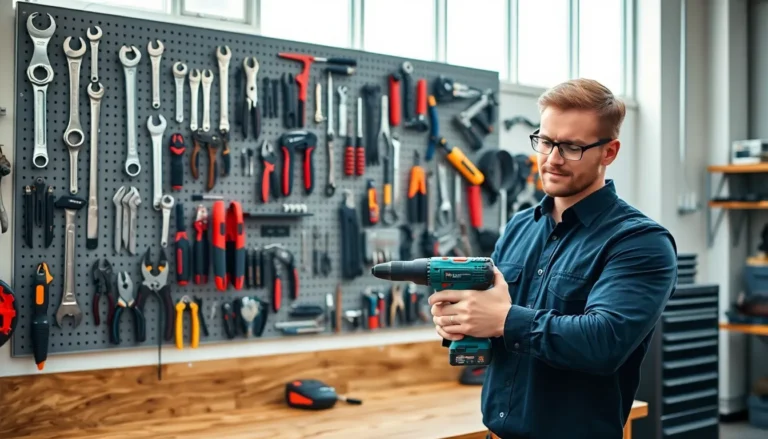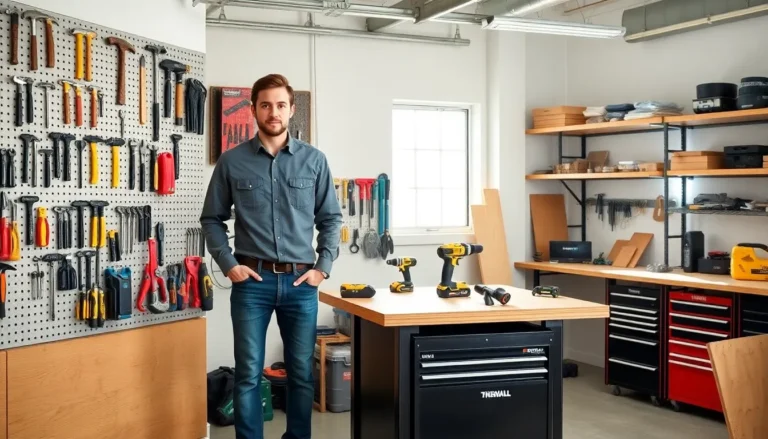Every workshop needs a layout that works as hard as the people in it. Imagine a space where tools are within arm’s reach and workstations flow seamlessly, like a well-choreographed dance. A smart workshop layout not only boosts productivity but also keeps frustration at bay. After all, nobody wants to spend precious time searching for that elusive wrench buried under a mountain of chaos.
Creating the perfect workshop layout isn’t just about aesthetics; it’s about efficiency and safety too. With the right design, workers can zip through tasks as if they’re on a mission, avoiding the dreaded “where did I put that?” blues. So, buckle up as we explore the art and science behind crafting a workshop layout that turns clutter into clarity and transforms workdays into smooth sailing adventures.
Table of Contents
ToggleImportance Of Workshop Layout
An effective workshop layout plays a crucial role in enhancing productivity. Organized workspaces significantly reduce time wasted searching for tools and materials. Efficient tool placement contributes to smoother workflows, allowing workers to focus on the tasks at hand. Safety standards improve when equipment and materials are stored properly, minimizing hazards from clutter.
Workstations must be designed with the user’s needs in mind. Each area should cater to specific tasks, improving both efficiency and comfort. Consistent organization promotes ease of use, helping workers avoid frustration and maintain concentration. Clear pathways and defined spaces for different activities lead to improved mobility and reduced risk of accidents.
A well-thought-out layout can facilitate better communication among team members. Open areas encourage collaboration, while designated quiet zones allow for focused work. Each design choice impacts worker morale, enhancing their overall job satisfaction when the environment aligns with their needs.
Space utilization is equally important. By maximizing the available area, workshops can accommodate more equipment and promote creative problem-solving. Flexibility in design allows for modifications in response to changing needs and project requirements over time. Data demonstrates that a well-planned workshop layout can increase productivity by up to 25%, underscoring its influence on operational success.
Every element, from lighting to storage, plays a role in the effectiveness of the workshop. Thoughtful integration of these factors supports effective work processes and ensures optimal workspace performance. Prioritizing a functional layout transforms the workshop into a more enjoyable environment, fostering both efficiency and employee well-being.
Key Components Of Effective Workshop Layout

Effective workshop layouts prioritize specific components that enhance efficiency and safety. Focusing on key elements leads to improved productivity and a more enjoyable work environment.
Work Zones
Designated work zones streamline tasks by providing clear areas for different activities. Each zone focuses on specific functions, whether for assembly, storage, or maintenance, allowing workers to navigate with ease. Additionally, arranging equipment and tools within each zone minimizes unnecessary movement, promoting quick access. Zones should accommodate various workflows, ensuring associates have everything needed at their fingertips. Creating a dynamic structure improves collaboration as team members can engage in focused discussions without disruption. Furthermore, proper signage enhances zone identification, guiding workers seamlessly through the space.
Workflow Optimization
Optimizing workflow begins with strategic layout planning that enhances movement. Arranging workstations to minimize travel distances allows workers to operate more efficiently. Each tool and material should be close to the workstation used most often, reducing downtime. Adopting a one-directional flow can lead to smoother operations, preventing bottlenecks and increasing productivity. Implementing visual management tools can also highlight areas needing attention, facilitating immediate adjustments. Data indicates that an effective workshop layout can boost productivity by up to 25%, emphasizing the critical role of alignment in design. Creating a balance between efficiency and usability fosters a workspace where workers feel empowered and productive.
Types Of Workshop Layouts
Workshops can adopt various layouts to enhance productivity and workflow. Understanding these layouts assists in selecting the best fit for specific tasks and operations.
Process Layout
Process layouts focus on the flow of similar tasks or operations. In a process layout, workstations align according to specific processes, creating a streamlined workflow. For example, a woodworking shop may position cutting stations near assembly areas. This arrangement minimizes unnecessary movement and reduces time wasted searching for tools. Customizing the layout to match the sequence of operations fosters efficiency, as workers can easily access needed tools.
Product Layout
Product layouts arrange workstations in a sequence based on the production process of a specific product. This type of layout is common in assembly line settings. Workers perform tasks in a designated order to assemble products efficiently. Establishing a clear workflow allows for consistent output and reduced production time. Product layouts enhance speed and efficiency, especially in large-scale production environments. Implementing this layout can lead to improved productivity, as data indicates a potential increase in output by up to 25%.
Fixed-Position Layout
Fixed-position layouts maintain equipment and materials in a single location, which suits projects requiring large assembly or construction. This layout allows workers to bring tools and materials to the project site. An example is in building construction, where the structure remains stationary while workers move around it. Flexibility is a notable advantage, as this layout supports larger items or complex projects. Worker collaboration improves due to the proximity of resources and team members, enhancing overall efficiency.
Tools And Software For Planning Layout
Effective workshop layout planning benefits from various tools and software. These solutions simplify the design process and enhance accuracy.
- CAD Software: Computer-Aided Design (CAD) software like AutoCAD and SolidWorks allows for precise layout modeling. Users can create detailed 2D and 3D representations of the workshop space.
- Floor Plan Tools: Applications such as SketchUp or Floorplanner help visualize layouts. They enable users to arrange furniture and equipment easily, promoting efficient space utilization.
- Simulation Software: Programs like AnyLogic offer simulation capabilities to test different layout scenarios. Users can analyze workflows and identify potential bottlenecks before implementing changes.
- Project Management Tools: Software like Trello or Asana organizes tasks related to layout planning. Keeping track of design stages and assignments boosts team collaboration and accountability.
- Lean Methodology Tools: Tools that support lean principles, such as Value Stream Mapping, help identify waste in processes. They guide users toward a layout that maximizes efficiency and minimizes unnecessary movement.
- Collaboration Platforms: Communication tools such as Slack or Microsoft Teams facilitate teamwork during the planning process. Users can share ideas and obtain feedback in real time, streamlining decision-making.
Incorporating data-driven insights also enhances layout planning. Workshop layouts that prioritize efficient tool placement achieve a productivity increase of up to 25%. This data underscores the importance of investing time and effort into selecting appropriate tools and software for effective layout design. Establishing a layout with the right resources transforms the work environment into a hub of efficiency and teamwork.
Best Practices For Designing A Workshop Layout
Organizing a workshop layout involves several best practices that enhance productivity. First, consider the flow of movement. Position workstations and tools to minimize unnecessary travel distances. Space organization promotes efficiency, ensuring workers spend less time searching for equipment.
Next, prioritize safety by maintaining clear pathways. Defined areas reduce hazards, such as clutter and potential accidents. Each workstation must cater to specific tasks, enhancing both comfort and efficiency.
Designated zones foster collaboration. Open spaces encourage teamwork, while quiet zones allow for focused work. Establishing clear boundaries between different activities improves mobility throughout the workshop.
Effective storage solutions play a crucial role in layout design. Utilize vertical space with shelving and overhead storage to maximize area. Clear labeling of tools and materials helps keep everything organized, making access quick and easy.
Flexibility in layout design allows adaptation to changing project needs. Easily reconfigurable workstations facilitate adjustments based on team requirements. Data demonstrates that a well-planned layout can boost productivity by up to 25%, showcasing its impact on operations.
Incorporate visual management tools to highlight important areas. This strategy aids in maintaining organization and facilitating immediate adjustments. Regular reviews of layout effectiveness help identify improvements and maintain optimal workflows.
Finally, leverage tools and software to refine the design process. CAD software and floor plan tools allow precise visualizations of the workspace. By embracing these best practices, a workshop layout can transform into a hub of efficiency, safety, and collaboration.
An effective workshop layout is essential for boosting productivity and ensuring safety. By prioritizing organization and accessibility, workers can focus on their tasks without unnecessary distractions. Thoughtful design fosters collaboration while maintaining designated spaces for focused work.
Flexibility in layout allows for adaptation to evolving project needs, enhancing overall efficiency. Utilizing tools and software can streamline the planning process, ensuring every aspect of the workshop is optimized.
Ultimately, investing in a well-planned workshop layout transforms the workspace into an environment that supports both efficiency and employee well-being. Prioritizing these elements will lead to a more productive and enjoyable experience for everyone involved.



